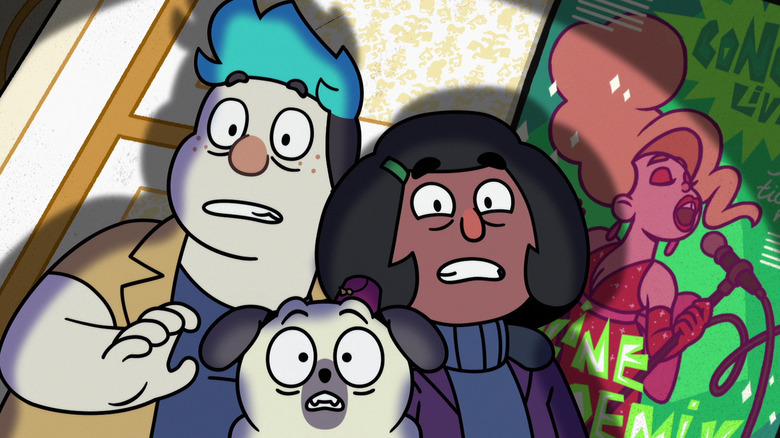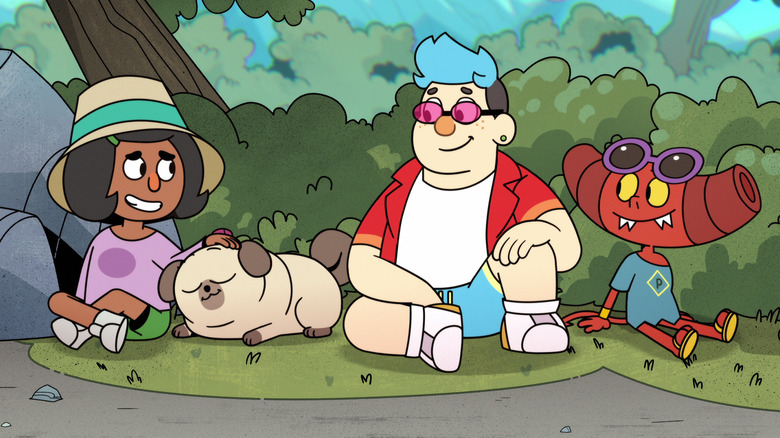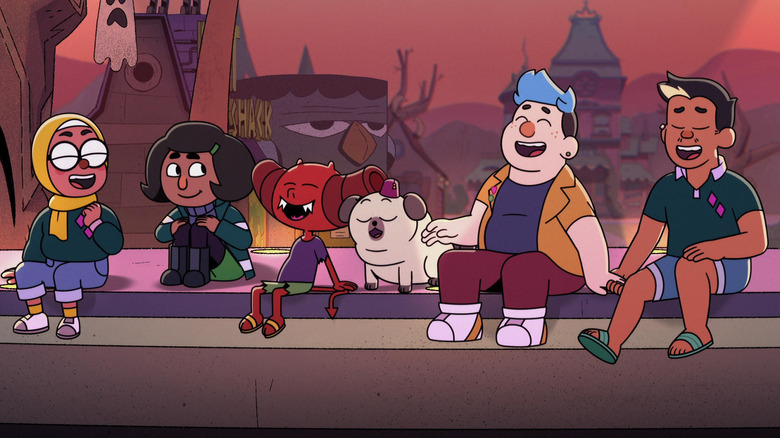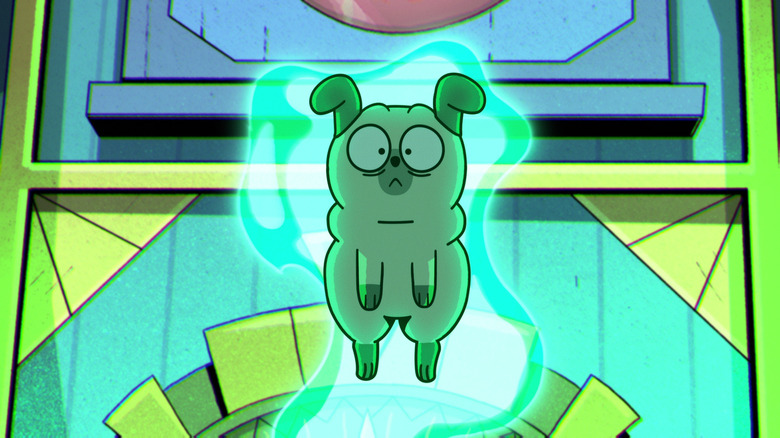Dead End: Paranormal Park Review: The Cartoon Comedy About Kids Working At A Haunted Amusement Park
Netflix has buried a repertoire of promising what-might-have-beens in a golden age of family-friendly western animation. You can't necessarily start a new Netflix cartoon without thinking about how the streamer giant has been in the news cycle for cutting down on creator-driven animation to save money in the face of its subscriber loss–and increasing subscription cost. While this doesn't mean all of its animated line-up has been canned, the canceled projects gesture to a chasm in which creative audacities, talents, forward-thinking themes, and possibly landmark creations have been flung into the dark.
Which brings us to "Dead End: Paranormal Park" (created by Hamish Steele, creator of the original graphic novel), the latest Netflix animation in the Kids & Family category to cast a spell.
Two human neighbors, Barney (Zach Barack) and Norma (Kody Kavitha), are employed as security guards at a theme park based on the famous blonde actress Pauline Phoenix (Clinton Leupp). They venture to its headquarters, a haunted mansion, to meet their interviewer: the sardonic demon Courtney (Emily Osment). But then they discover that they were intended as a human sacrifice to the demonic Temeluchus (Alex Brightman), who seeks a flesh body to possess. In a bid to protect his human, Barney's pet pug, Pugsley (also Brightman), flings himself in the demon's path and gets possessed. The possession leaves Pugsley with not only talking abilities but magical powers, which play a large role in episodic shenanigans filled with sleep-sucking hags, ghastly spirits, and hungry demons. Ultimately, the kids find themselves investigating the disappearance (and unscrupulous dealings) of its missing owner, Pauline Phoenix.
The cast of mortals and demons
At its most poignant, the show focuses on the social grapplings within kids like Barney and Norma. Barney has compunctions about leaving his family (more on that) while he invests in the joy of making a new start and forging a found family. Though psyched to work in the theme park and loaded with ramble-worthy encyclopedic trivia of Pauline Phoenix's filmography, Norma confronts social situations outside of her comfort zone (done with honesty to the neurodivergent experience) — and some reckoning the deeper she gets into the mystery. As for Pugsley, he's the comic relief (he says so himself), but it belies the fact that his newfound powers make him the lynchpin of the supernatural dealings.
Zach Barack supplies Barney with delicate anxiety. Kavitha conveys Norma's ease of rambly braininess. As for other park staff, Badyah (Kathreen Khavari) is a priceless pairing with Norma and balances out her ostentatious obsessiveness. Barney also goes gaga for a love interest, the easygoing Logan (Kenny Tran), that makes for a cute courtship.
Alex Brightman, who exercises his notorious vocal strain from the "Beetlejuice" musical, steals the scene and makes the swerves into Pugsley's demonic mode and nice-guy benign mode. But competing with Pugsley's scene-stealing is Courtney, mischievous with morals-in-training, who wants to go back to her demonic homeworld. Applying jagged inflections, Osment is the most pleasant surprise of all—her "I want" song number that subverts Disney skyward-troped lyricism is the major highlight.
Leupp is wickedly fun as the self-absorbed Pauline Phoenix. Mj Rodriguez emits an oozingly delicious hammy performance as a character I won't disclose. I also have a feeling that a character played by Karen Maruyama could be a memetic favorite.
Entering the canon of LGBTQ+ rep in children's animation
Starring a transgender lead voiced by transgender actor Zach Barack, "Dead End" also enters a cartoon canon of unapologetic leading LGBTQ+ rep in western children's cartoons alongside "Steven Universe," "Kipo and the Age of Wonderbeasts," "She-Ra and the Princesses of Power," and a growing list of other kid-aimed cartoons starring transgender characters. In the stated examples, queerness unabashedly exists in its worldbuilding (not to say coded queerphobia is non-existent in the case of "Steven Universe"). In this case, "Dead End" stars a human transgender person front-and-center and undertakes an arc-long depiction of the impact of transphobia in a way that leans toward real-world societal implications. (Not surprisingly, the cartoon's existence has enraged U.S. senators in a nation where people in power are enacting dehumanizing exclusionary policies and the elimination of transgender healthcare.)
One point of discussion is observing how trauma (highly implied deadnaming and misgendering) leaves Barney the burden of negotiating with his wishes: he blames himself for not telling his parents and brother that he ran away but he ultimately doesn't apologize for leaving an unsafe household. "Dead End" pushes against the feeble notion that tolerating and cheerfully insisting you support your transgender child's identity is just enough and they should feel grateful for bare minimums (going off the Vol. 1 of the graphic novel, there's a notable change from the theme of "parents didn't accept him" to "parents want to accept him yet failed to have his back").
Being loving to your transgender child means holding your own loved ones to account when they spout harmful words. Not to say there are elements in "Dead End" representation of a trans experience I find uncritique-able: I, as a queer cisgender writer, think the arc for Barney to guilt-trip himself for not "facing his demons" and running away, even after he vocalizes his needs to his family, warrants examination. Still, "Dead End" would hopefully help kick open the door for many transgender creators, as expressed by the show's creator, who even as a gay white cisgender male possessed industry-shaped anxiety that was met with the privilege of an uncompromised vision under Netflix). Against the hypocrisy of Netflix also platforming transphobic rhetoric under the guise of comedy, the existence of "Dead End" and transgender-led cartoon creations like Shadi Petosky's "Danger & Eggs" (Prime Video) is important.
The animation
With animation produced by the London-based Blink Industries studio, the art direction is vibrant and colorful. The character designs by Hamish Steele's team (Liz Whitaker as series director) yield a crisp rounded style. Not dissimilar to "Hilda," the cartoon takes a de-coarsing approach to the source material graphic novel's style (for better or worse, readers of the graphic novel may picture how a style closer to Steele's original aesthetic could potentially soar in ways the final product can't). There is a sequence where the animation flaunts its experimentation that unfurls visual surprises, particularly where it tackles a social anxiety attack with ruthless surreality (innocuous comments being processed as caricatured negativity).
The first three episodes are a stroll that acquaints you with the cast's quirks and frailties and a lay of the land. But the real madcap madness twirls off when the cast does the game show in the pits of Hell, then dives into a genre-riff of television, and then a penultimate musical episode (music and lyrics by Patrick Stump, Steele, Jen Bardekoff). With 10 episodes for season 1, "Dead End" does get clumpy toward its finale, mainly because two big bads compete for the spotlight ("I'm the big bad around here" lampshades the cramming of the two villains).
For those who follow the likes of "Gravity Falls," there's plenty of macabre and gallows humor to go around. The mystery is more of a means to flesh out the interactions, be it characters communicating with others or their environment, and its reflexive sense of humor (Nicole Paglia serves as head writer). "Dead End" is designed to be consumed episodically while having the ending-teaser trademarks of the binge-watch. Time will tell whether this show would attract an audience who love piecing together clues to the extent of "Gravity Falls" since there are teases for season 2.
"Dead End: Paranormal Park" is now streaming on Netflix.



